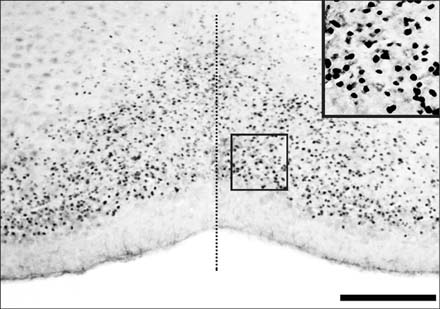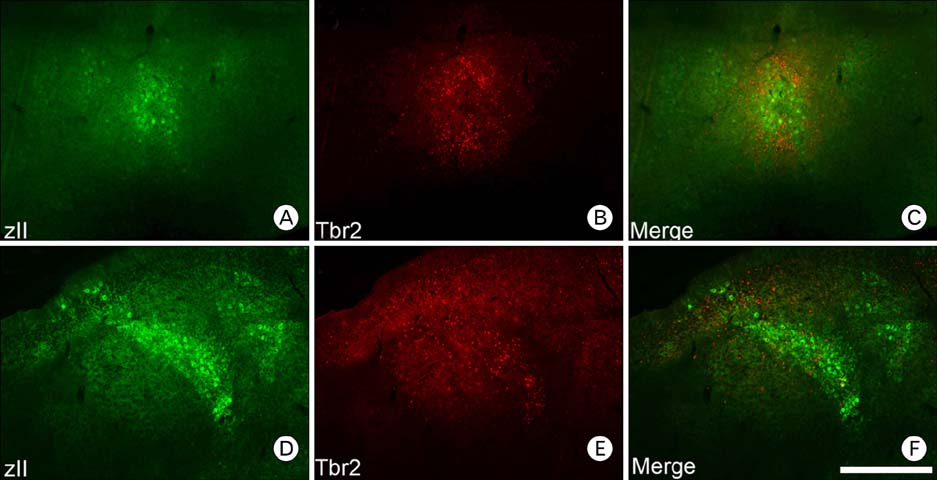Anat Cell Biol.
2010 Mar;43(1):72-77. 10.5115/acb.2010.43.1.72.
TBR2-immunopsitive unipolar brush cells are associated with ectopic zebrin II-immunoreactive Purkinje cell clusters in the cerebellum of scrambler mice
- Affiliations
-
- 1Department of Cell Biology and Human Anatomy, School of Medicine, University of California, Davis, Sacramento, California 95817, USA.
- 2Department of Anatomy, College of Medicine, Konyang University, Daejeon, Korea. nslee@konyang.ac.kr
- KMID: 2168899
- DOI: http://doi.org/10.5115/acb.2010.43.1.72
Abstract
- Unipolar brush cells (UBCs) are excitatory interneurons with their somata located in the granular layer. Recently, T-brain factor 2 (Tbr2) was shown to be expressed in a subset of UBCs in mouse cerebellum. Scrambler mice exhibit severe cerebellum abnormalities, including the failure of embryonic Purkinje cell dispersal and a complete absence of foliation due to a mutation in the disabled-1 adaptor protein. Since most UBC markers are expressed postnatally, it has proven difficult to identify the relationship between developing Purkinje cell clusters and migrating UBCs. Because scrambler mice closely mimic normal embryonic day 18 cerebellum, we examined whether Tbr2-positive UBCs are associated with Purkinje cell cluster markers such as zebrin II, which is the most studied compartmentation marker in the cerebellum. We investigated the distribution of Tbr2-positive UBCs in this mutant by using anti-Tbr2 immunocytochemistry. The data revealed that Tbr2 immunoreactivity was exclusively present in the nucleus of UBCs in scrambler cerebellum. Based on expression data, a Tbr2-positive UBC map was constructed. In addition, Tbr2-positive UBCs are found associated with ectopic zebrin II-immunoreactive Purkinje cell clusters in scrambler cerebellum. These data suggest that UBCs use Purkinje cell compartmentation to migrate into their final position through interactions with the embryonic array of specific Purkinje cell subtypes.
Keyword
MeSH Terms
Figure
Reference
-
1. Abbott LC, Jacobowitz DM. Development of calretinin-immunoreactive unipolar brush-like cells and an afferent pathway to the embryonic and early postnatal mouse cerebellum. Anat Embryol Berl. 1995. 191:541–559.2. Ahn AH, Dziennis S, Hawkes R, Herrup K. The cloning of zebrin II reveals its identity with aldolase C. Development. 1994. 120:2081–2090.3. Altman J, Bayer SA. Time of origin and distribution of a new cell type in the rat cerebellar cortex. Exp Brain Res. 1977. 29:265–274.4. Armstrong CL, Hawkes R. Pattern formation in the cerebellar cortex. Biochem Cell Biol. 2000. 78:551–562.5. Brochu G, Maler L, Hawkes R. Zebrin II: a polypeptide antigen expressed selectively by Purkinje cells reveals compartments in rat and fish cerebellum. J Comp Neurol. 1990. 291:538–552.6. Chung SH, Sillitoe RV, Croci L, Badaloni A, Consalez G, Hawkes R. Purkinje cell phenotype restricts the distribution of unipolar brush cells. Neuroscience. 2009. 164:1496–1508.7. Eisenman LM. Antero-posterior boundaries and compartments in the cerebellum: evidence from selected neurological mutants. Prog Brain Res. 2000. 124:23–30.8. Englund C, Kowalczyk T, Daza RA, et al. Unipolar brush cells of the cerebellum are produced in the rhombic lip and migrate through developing white matter. J Neurosci. 2006. 26:9184–9195.9. Floris A, Dino M, Jacobowitz DM, et al. The unipolar brush cells of the rat cerebellar cortex and cochlear nucleus are calretinin-positive: a study by light and electron microscopic immunocytochemistry. Anat Embryol. 1994. 189:495–520.10. Goldowitz D, Cushing RC, Laywell E, et al. Cerebellar disorganization characteristic of reeler in scrambler mutant mice despite presence of reelin. J Neurosci. 1997. 17:8767–8777.11. Hawkes R. An anatomical model of cerebellar modules. Prog Brain Res. 1997. 114:39–52.12. Hawkes R, Eisenman LM. Stripes and zones: the origins of regionalization of the adult cerebellum. Perspect Dev Neurobiol. 1997. 5:95–105.13. Hawkes R, Gravel C. The modular cerebellum. Prog Neurobiol. 1991. 36:309–327.14. Howell BW, Hawkes R, Soriano P, Cooper JA. Neuronal position in the developing brain is regulated by mouse disabled-1. Nature. 1997. 389:733–737.15. Mugnaini E, Floris A. The unipolar brush cell: a neglected neuron of the mammalian cerebellar cortex. J Comp Neurol. 1994. 339:174–180.16. Nunzi MG, Birnstiel S, Bhattacharyya BJ, Slater NT, Mugnaini E. Unipolar brush cells form a glutamatergic projection system within the mouse cerebellar cortex. J Comp Neurol. 2001. 434:329–341.17. Nunzi MG, Mugnaini E. Unipolar brush cell axons form a large system of intrinsic mossy fibers in the postnatal vestibulocerebellum. J Comp Neurol. 2000. 422:55–65.18. Nunzi MG, Shigemoto R, Mugnaini E. Differential expression of calretinin and metabotropic glutamate receptor mGluR1 alpha defines subsets of unipolar brush cells in mouse cerebellum. J Comp Neurol. 2002. 451:189–199.19. Ozol KO, Hawkes R. compartmentation of the granular layer of the cerebellum. Histol Histopathol. 1997. 12:171–184.20. Ozol K, Hayden JM, Oberdick J, Hawkes R. Transverse zones in the vermis of the mouse cerebellum. J Comp Neurol. 1999. 412:95–111.21. Sheldon M, Rice DS, D'Arcangelo G, et al. Scrambler and yotari disrupt the disabled gene and produce a reeler-like phenotype in mice. Nature. 1997. 389:730–733.22. Sotelo C, Chédotal A. Development of the olivocerebellar system: migration and formation of cerebellar maps. Prog Brain Res. 2005. 148:1–20.23. Sweet HO, Bronson RT, Johnson KR, Cook SA, Davisson MT. Scrambler, a new neurological mutation of the mouse with abnormalities of neuronal migration. Mamm Genome. 1996. 7:798–802.
- Full Text Links
- Actions
-
Cited
- CITED
-
- Close
- Share
- Similar articles
-
- Differences of Zebrin II Expression Pattern Between Normal Balb/C and Ataxic Pogo Mouse Cerebellum
- Abnormal Expression of Neuropeptide Y in the Cerebellar Purkinje Cells of the Ataxic Mutant Mice, Pogo
- Distribution of Calretinin-immunoreactive Unipolar Brush Cells in Ataxic Mutant Pogo Mice Cerebellum
- Immunohistochemistry of Voltage-Gated Calcium Channel alpha1B Subunit in Mouse Cerebellum
- Early cerebellar granule cell migration in the mouse embryonic development




